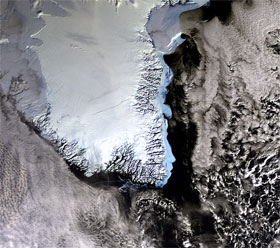Sun, not carbon dioxide, primary driver of ice ages says new theory
Sun, not carbon dioxide, primary driver of ice ages says new theory
mongabay.com
July 24, 2006
A new theory says that carbon dioxide is only a secondary driver of ice ages.
In a paper published online in the journal Climate of the Past, William Ruddiman, an environmental scientist with the University of Virginia, argues that “carbon dioxide is a driver of ice sheets only at the relatively small 23,000-year cycle, but not at the much larger ice-volume cycles at 41,000 years and approximately 100,000 years” according to a news release from the university.
For longer intervals, ice sheets are initially driven by the Sun, with carbon dioxide providing an amplifying effect.
The University of Virginia news release appears below.
Ice sheets drive atmospheric carbon dioxide levels, inverting previous ice-age theory
University of Virginia
In the early 20th century, Milutin Milankovitch, a leading astronomer and climatologist of the time, proposed that the Earth’s ice-age cycles could be predicted because they correspond directly with routine changes in the Earth’s orbit and its tilt over cycles of tens of thousands of years. Because of these changes, there are predictable variations in the amount of solar radiation striking the Earth’s surface. Milankovitch argued that low levels of summer radiation permit snow to accumulate as permanent ice, while high levels of solar radiation melt snow and ice.

This image of South Greenland was acquired on 16 February 2006 by Envisat’s Medium Resolution Imaging Spectrometer (MERIS), working in Reduced Resolution mode. Credits: European Space Agency |
It all seemed so clean and simple.
And indeed the hypothesis was partially confirmed in the 1970s from marine sediment records extending through 2.75 million years of northern hemisphere ice-age cycles. As Milankovitch predicted, ice grew and melted at cycles of 23,000 and 41,000 years. But two observations were unexpected: from 2.75 until 0.9 million years ago, the ice sheets grew and melted almost entirely at the 41,000-year cycle. Since then, an oscillation near 100,000 years has dominated.
This knocked Milankovitch’s theory for a loop.
Scientists have since turned to changes in atmospheric carbon dioxide as a possible explanation. Carbon dioxide concentrations can be measured in ancient air bubbles preserved in sequences of cores drilled into the Antarctic ice sheet. Because some changes in carbon dioxide have been found to occur slightly before changes in ice volume, the prevailing interpretation has been that carbon dioxide is an additional independent ‘driver’ of the size of ice sheets, along with solar radiation.
Now, a new hypothesis inverts this view.
William Ruddiman, an environmental scientist with the University of Virginia, provides a novel explanation for the rhythms of the ice ages in a paper just published online in the journal Climate of the Past. Ruddiman found that carbon dioxide is a driver of ice sheets only at the relatively small 23,000-year cycle, but not at the much larger ice-volume cycles at 41,000 years and approximately 100,000 years. In those cases he found that ice sheets instead control atmospheric carbon dioxide and drive feedbacks that amplify ice growth and melting. He says his carbon dioxide feedback hypothesis explains why the strongest cycles of ice response are not in correspondence with those in the orbital cycles.
Ruddiman concludes (as Milankovitch proposed) that ice sheets are initially driven by the Sun, but then the ice takes control of carbon dioxide changes, producing its own positive feedback (the amplifying effect) at the 41,000-year cycle.
This enhancement explains the strength of the 41,000-year ice-sheet changes over the first two-thirds of the ice ages. But over time, as polar climate cooled, summer melting weakened. During the last 0.9 million years, ice sheets have continued to grow at the 41,000-year cycle, but some of the new ice remained in place to help build larger ice sheets. Ice build-up continued until unusually large solar radiation peaks triggered rapid melting at intervals of 85,000 to 115,000 years. Although solar radiation peaks were the initial trigger for these melting episodes, most of the ice was removed by feedbacks in the climate system, and CO2 feedback was the largest of these.
“The origin of the ice-age cycles has been a major mystery in studies of past climates, and some scientists felt the answer must be very complex,” Ruddiman said. “Yet this hypothesis is quite simple, requiring only the Sun, the carbon dioxide feedback, and a gradual cooling. The prominent role proposed for carbon dioxide is consistent with its likely effect on future climate.”
notes:
Two years ago Ruddiman published a study hypothesizing that humans have been altering the global climate for thousands of years since the advent of agriculture, possibly halting the start of a new ice age. That study received extensive international media coverage and is still being widely discussed in the climate community.
His new paper can be accessed at: http://www.climate-of-the-past.net/. From that page, type “Ruddiman” where it says, “Site search ” From there, find the Ruddiman paper “Ice-driven CO feedback on ice volume” as a PDF file or in HTML form.














